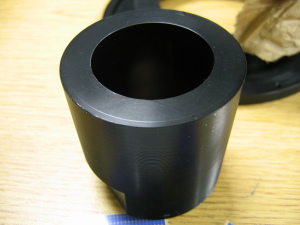An upcoming presentation at the 61st annual AVS Conference (Nov. 9 – 14, 2014) features a fibre made of tungsten that when added to kevlar offers the possibility of ‘tough’ electronics. From an Oct. 31, 2014 news item on Nanowerk (Note: A link has been removed),
A group of North Carolina State University researchers is exploring novel ways to apply semiconductor industry processes to unique substrates, such as textiles and fabrics, to “weave together” multifunctional materials with distinct capabilities.
During the AVS 61st International Symposium & Exhibition, being held November 9-14, 2014, in Baltimore, Maryland, the researchers will describe how they were able to “weave” high-strength, highly conductive yarns made of tungsten metal on Kevlar — aka body armor material — by using atomic layer deposition (ALD), a process commonly used for producing memory and logic devices.
An Oct. 28, 2014 AVS: Science & Technology of Materials, Interfaces, and Processing news release on Newswire, which originated the news item provides more details about this multifunctional material and a good description of atomic layer deposition (ALD),
“As a substrate, Kevlar was intriguing to us because it’s capable of withstanding the relatively high temperature (220°C) required by the ALD deposition process,” explains Sarah Atanasov, a Ph.D. candidate in the Biomolecular Engineering Department at North Carolina State University. “Kevlar doesn’t begin to degrade until it reaches nearly 400°C.”
The group selected ALD as a process because it allows them to deposit highly conformal films on nonplanar surfaces with nanometer-thickness precision. “This ensures that the entire surface of the yarn — made of nearly 600 fibers, each 12 microns in diameter — is evenly coated,” said Atanasov.
How does the ALD process work? It’s actually a cyclical process, which begins by exposing the substrate’s surface to one gas-phase chemical, in this case tungsten hexafluoride (WF6), followed by removal of any unreacted material. This is chased with surface exposure to a second gas-phase chemical, silane (SiH4), after which any unreacted material is once again removed.
By the end of the ALD cycle, the two chemicals have reacted to produce tungsten. “This is a self-limited process, meaning that a single atomic layer is deposited during each cycle — in this case ~5.5 Angstroms per cycle,” Atanasov said. “The process can be cycled through a number of times to achieve any specifically desired thickness. As a bonus, ALD occurs in the gas phase, so it doesn’t require any solution processing and is considered to be a more sustainable deposition technique.”
While weaving together multiple fabrics to combine multiple capabilities certainly isn’t new, characteristics such as high strength, high conductivity, and flexibility are frequently regarded as being mutually exclusive — so concessions are often made to get the most important one.
The work by Atanasov and colleagues shows, however, that ALD of tungsten on Kevlar yields yarns that are highly flexible and highly conductive, around 2,000 S/cm (“Siemens per centimeter,” a common unit used for conductivity). The yards are also within 90 percent of their original prior-to-coating tensile strength.
“Introducing well-established processes from one area into a completely new field can lead to some very interesting and useful results,” Atanasov noted.
The group’s tungsten-on-Kevlar yarns are expected to find applications in multifunctional protective electronics materials for electromagnetic shielding and communications, as well as erosion-resistant antistatic fabrics for space and automated technologies.
Presentation #MS+PS+TF-ThA4, “Multifunctional Fabrics via Tungsten ALD on Kevlar,” authored by Sarah Atanasov, B. Kalanyan and G.N. Parsons, will be at 3:20 p.m. ET on Thursday, Nov. 13, 2014.
Atanasov recently published a paper about another kevlar project where she worked to enhance its ‘stab resistance’ with a titanium dioxide/aluminum mixture as Anisha Ratan notes in her Sept. 12, 2014 article (Oxide armour offers Kevlar better stab resistance) (excerpt from Ratan’s article for the Royal Society; Note: Links have been removed),
Scientists in the US have synthesised an ultrathin inorganic bilayer coating for Kevlar that could improve its stab resistance by 30% and prove invaluable for military and first-responders requiring multi-threat protection clothes.
Developed in 1965 by Stephanie Kwolek at DuPont, poly(p-phenylene terephthalamide) (PPTA), or Kevlar, is a para-aramid synthetic fiber deriving its strength from interchain hydrogen bonding. It finds use in flexible energy and electronic systems, but is most commonly associated with bullet-proof body armour.
However, despite its anti-ballistic properties, it offers limited cut and stab protection. In a bid to overcome this drawback, Sarah Atanasov, from Gregory Parsons’ group at North Carolina State University, and colleagues, have developed a TiO2/Al2O3 bilayer that significantly enhances the cut resistance of Kevlar fibers. The coating is added to Kevlar by atomic layer deposition, a low temperature technique with nanoscale precision.
Unfortunately the team’s research paper is no longer open access but you can find a link to it from Ratan’s article.
